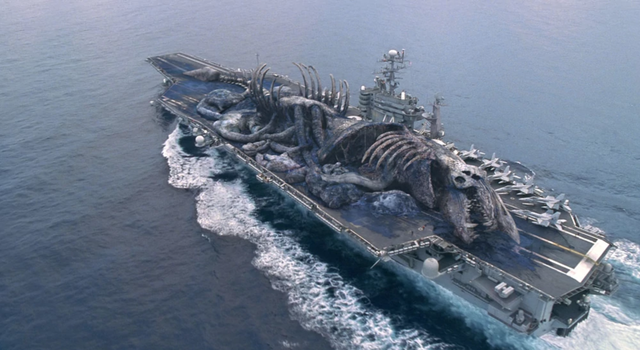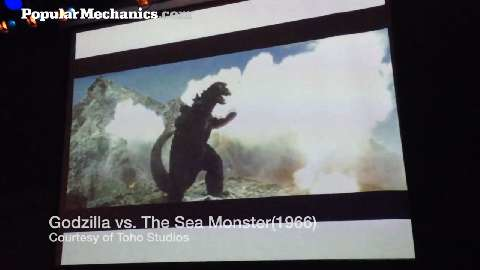"James Cameron's Story of Sci-Fi" airs tonight on AMC at 10 PM Eastern. The third episode of this six-part series focuses on space monsters and how they've been portrayed in science fiction.
(This post was originally published in July 2013 to address how to fight the monsters in Pacific Rim. We find that its suggestions are still valid for the latest installment, Pacific Rim Uprising, and for attacking any other space monsters that might trouble humanity.)
Want to fight a space monster? First, don't go toe-to-toe with them on the ground.
Infantry should be reserved for evacuations, crowd control and to preserve civil order. Once it's been shown that the animal's hide is too thick for bullets and shoulder-fired rockets to have any effect (and this always proves to be the case), withdraw the soldiers and Marines from the front lines.
A tank seems like a fine monster-killing machine. Take the M1A1 Abrams for example. It's pretty fast, with a top speed of 45 mph, so it can get to where the monster is pretty quickly. The tank can be sealed from chemical and biological threats outside, which should always be a priority when an unknown species descends from the sky or emerges from an inter-dimensional rift in the ocean depths.
The tank's 120mm main gun fires high explosive rounds or, even better, kinetic rounds that can punch holes in almost anything. But from the star of Godzilla to the creatures of Pacific Rim, the beasts that will attack will probably shrug off these shells as nothing more than pinpricks. And tanks are tough, but they are not designed to withstand the crushing force of a 300 foot tall dinosaur stomping on them. At the least, the suspension will be wrecked. At the most, the whole vehicle will be crushed and entomb the four crewmembers within.
The Army could play a role in the fight, but only in the air. AH-64 Apache helicopters would be adept monster hunters, except most of its arms are also light. A 30mm chain gun is ferocious, but if a 50-caliber machine gun on a tank has no effect, there's not much hope that the helo can score any hits.
The advantage, however, is that the helicopter can stay out of range and aim for sensitive spots on the beasts, like the eyes, mouth, gills and so on. Even better, the Apache can carry 70mm rocket pods and laser-guided Hellfire missiles. A face full of these would make the King of Monsters himself take notice.
So here's the tactic—use the Apaches to get the monster's attention, and draw it out of the cities. That would enable the other services to take a crack at killing it. (And let's hope the creature can't unfold unexpected wings and take flight).
Monster Killing Air Power
The most galling thing about monster movies—besides the marginal, comic-relief characters—is the way they botch the way airplanes kill ground targets.
In most movies, directors want to show the airplane shooting at the target (whether it's a kaiju in Pacific Rim or John McClane in A Good Day to Die Hard) in one frame. So they drop the airplane to a suicidal altitude.
In Pacific Rim, F-22 Raptor pilots careen at chest level with the monsters, spraying them with machine gun fire. (I suppose their missiles have been exhausted.) The stealth warplanes, probably the most maneuverable ever devised by engineers, are then knocked out the sky by the creature's claws. Think about it: Why would a pilot ever get within range of a monster's limbs? By taking a dive bomb approach, the warplane gets more time to fire, and from a safer vantage.
Even so, the Raptor is not the best monster killer. Few fighter aircraft would be, since they are armed with heat-seeking and radar guided missiles meant to kill other airplanes beyond the line of sight. Now that we've seen that altitude and the size of the bomb are the most important factors, it's obvious that a bomber is called for.
In Cloverfield, the survivors of ravaged New York City see the Air Force engage the monster with a B-2 Spirit stealth bomber. Bad choice. The B-2 is an amazing airplane, but the pilots use GPS-guided munitions. Not the best choice when hunting a monster that can cruise around New York City faster than the President of the United States heading to a midtown fundraiser. The B-2 is only a good warplane if it's delivering the final option—a nuke.
Other bombers offer better options. The B-52 Stratofortress may be the most fitting option. Godzilla, the father of all kaiju, first appeared on screen in 1954. The B-52 was introduced into the Air Force's fleet a year later. More than 60 years and plenty of upgrades later, the airplanes are still flying combat missions. Just this year, B-52s receiving targeting pods that enable ground troops to designate targets with a laser, and the B-52 can drop lots of guided bombs from its 30-foot-long bomb bay.
The problem with the B-52 is that it takes too long to get over a target. So maybe the go-to bomber is the B-1 Lancer, an oft forgotten bomber that can speed to Mach 1.25 when it needs to. When a monster is flattening a city, every second equals tens of millions of dollars in damage. Lancers are not stealthy, so they have been built to be maneuverable enough to dodge antiaircraft missiles—or flying kaiju, if that becomes an issue. B-1s have been using the same targeting pods as the B-52 just received to kill moving targets on the ground.
So here's the plan: Apache helicopters enrage the creature with chain guns and missiles from an acceptable stand-off range. They could also pop up from behind buildings and hills, take their shots, and dip down again. Once the creature is coaxed into an open area, troops on the ground paint it with lasers. The B-1s overhead drop their full load of precision bombs on the thing. Lancers can carry BLU-109 penetrating bombs that can burrow into a bunker before exploding. These could burrow through the hide of a beast and detonate within.
Giant robots may be cool—okay they definitely are—but we can handle monsters just fine when they lumber onto land. If they stay at sea… well, they can stay there as long as they behave. Our submarines would be no match for a native born swimmer with a bad attitude.
"James Cameron's Story of Sci-Fi" airs tonight on AMC at 10 PM Eastern. The third episode of this six-part series focuses on space monsters and how they've been portrayed in science fiction.
Joe Pappalardo is a contributing writer at Popular Mechanics and author of the new book, Spaceport Earth: The Reinvention of Spaceflight.






